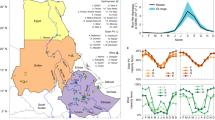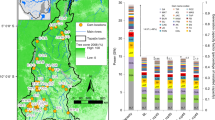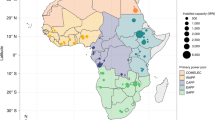Abstract
Hydropower comprises a significant and rapidly expanding proportion of electricity production in eastern and southern Africa. In both regions, hydropower is exposed to high levels of climate variability and regional climate linkages are strong, yet an understanding of spatial interdependences is lacking. Here we consider river basin configuration and define regions of coherent rainfall variability using cluster analysis to illustrate exposure to the risk of hydropower supply disruption of current (2015) and planned (2030) hydropower sites. Assuming completion of the dams planned, hydropower will become increasingly concentrated in the Nile (from 62% to 82% of total regional capacity) and Zambezi (from 73% to 85%) basins. By 2030, 70% and 59% of total hydropower capacity will be located in one cluster of rainfall variability in eastern and southern Africa, respectively, increasing the risk of concurrent climate-related electricity supply disruption in each region. Linking of nascent regional electricity sharing mechanisms could mitigate intraregional risk, although these mechanisms face considerable political and infrastructural challenges.
This is a preview of subscription content, access via your institution
Access options
Access Nature and 54 other Nature Portfolio journals
Get Nature+, our best-value online-access subscription
$29.99 / 30 days
cancel any time
Subscribe to this journal
Receive 12 digital issues and online access to articles
$119.00 per year
only $9.92 per issue
Buy this article
- Purchase on Springer Link
- Instant access to full article PDF
Prices may be subject to local taxes which are calculated during checkout



Similar content being viewed by others
References
Africa Development Indicators 2012/13 (World Bank, Washington, DC, 2013).
McDonald, K., Bosshard, P. & Brewer, N. Exporting dams: China’s hydropower industry goes global. J. Env. Manag. 90, S294–S302 (2009).
Dong, B. & Sutton, R. Dominant role of greenhouse-gas forcing in the recovery of Sahel rainfall. Nat. Clim. Change 5, 757–760 (2015).
Conway, D. et al. Precipitation and water resources variability in sub-Saharan Africa during the 20th century. J. Hydrom. 10, 41–59 (2009).
Mason, S. J. & Jury, M. R. Climate variability and change over southern Africa: a reflection on underlying processes. Prog. Phys. Geog. 21, 23–50 (1997).
Schaeffer, R. et al. Energy sector vulnerability to climate change: a review. Energy 38, 1–12 (2012).
Casal, M. Jr Drought: Hydropower's Achilles heel International Rivers (16 May 2016).
Dams and Energy Sectors Interdependency Study (DOE, 2011).
Thompson, J. Mapping drought's impact on electricity generation High Country News (7 July 2015).
de Lucena, A. F. P., Schaeffer, R. & Szklo, A. S. Least-cost adaptation options for global climate change impacts on the Brazilian electric power system. Glob. Environ. Change 20, 342–350 (2010).
Poindexter, G. B. 2016 Drought eases and continues in Brazil, affecting hydroelectric power generation Hydroworld (3 January 2016).
Eberhard, A., Rosnes, O., Shkaratan, M. & Vennemo, H. Africa’s Power Infrastructure: Investment, Integration, Efficiency (World Bank, Washington, 2011).
Beilfuss R. A. Risky climate for southern African hydro: assessing hydrological risks and consequences for Zambezi River basin dams International Rivers (19 September 2012).
Sanji, K. Malawi's hydropower dries up as river runs low, menacing forests Reuters (29 October 2015).
Tanzania closing hydropower plants BBC (9 October 2015).
Zambia to deepen power cuts after drought affects hydro plant Reuters (1 September 2015).
Kozacek, C. Zambia electricity shortage highlights Africa’s hydropower shortfalls Waternews (22 July 2015).
The PIDA Energy Vision (Programme for Infrastructure Development in Africa, 2016).
Richard, Y., Trzaska, S., Roucou, P. & Rouault, M. Modification of the southern African rainfall variability/ENSO relationship since the late 1960s. Clim. Dyn. 16, 883–895 (2000).
Conway, D., Hanson, C. E., Doherty, R. & Persechino, A. GCM simulations of the Indian Ocean dipole influence on East African rainfall: Present and future. Geophys. Res. Lett. 34, L03705 (2007).
Eltahir, E. A. El Niño and the natural variability in the flow of the Nile River. Water. Resour. Res. 32, 131–137 (1996).
Cervigni, R., Liden, R., Neumann, J. E. & Strzepek, K. M. Enhancing the Climate Resilience of Africa’s Infrastructure: The Power and Water Sectors (World Bank, Washington DC, 2015).
Conway, D. & Hulme, M. Recent fluctuations in precipitation and runoff over the Nile subbasins and their impacts on Main Nile discharge. Climatic Change 25, 127–151 (1993).
Jury, M. R. The coherent variability of African river flows: composite climate structure and the Atlantic circulation. Water SA 29, 1–10 (2003).
Dieppois, B., Rouault, M. & New, M. The impact of ENSO on Southern African rainfall in CMIP5 ocean atmosphere coupled climate models. Clim. Dyn. 45, 2425–2442 (2015).
Bowen, B. H., Sparrow, F. T. & Yu, Z. Modeling electricity trade policy for the twelve nations of the Southern African Power Pool (SAPP). Util. Policy 8, 183–197 (1999).
Southern African Power Pool Annual Report 2014 (SAPP, 2014).
Olukoju, A. ‘Never Expect Power Always’: electricity consumers’ response to monopoly, corruption and inefficient services in Nigeria. Afr. Aff. 103, 51–71 (2012).
Escribano, A., Luis Guasch, J. & Pena, J. Assessing the Impact of Infrastructure Quality on Firm Productivity in Africa; Cross Country Comparisons based on Investment Climate Surveys from 1999 to 2005. Policy Research Working Paper 5191 (World Bank, 2010).
Sheffield, J. et al. A drought monitoring and forecasting system for sub-Sahara African water resources and food security. Bull. Am. Meteorol. Soc. 95, 861–882 (2014).
Eberhard, A., Gratwick, K., Morello, E. & Antmann, P. Accelerating investments in power in sub-Saharan Africa. Nat. Energy 2, 17005 (2017).
Africa Progress Panel. Lights, Power, Action: Electrifying Africa (Africa Progress Panel, Geneva, 2017).
van Vliet, M. T. H., Wiberg, D., Leduc, S. & Riahi, K. Power-generation system vulnerability and adaptation to changes in climate and water resources. Nat. Clim. Change 6, 375–380 (2016).
Kling, H., Stanzel, P. & Preishuber, M. Impact modelling of water resources development and climate scenarios on Zambezi River discharge. J. Hydrol. Reg. Stud. 1, 17–43 (2014).
Spalding-Fecher, R., Joyce, B. & Winkler, H. Climate change and hydropower in the Southern African Power Pool and Zambezi River Basin: system-wide impacts and policy implications. Energy Policy. 103, 84–97 (2017).
Hellmuth, M., Cookson, P. & Potter, J. Addressing Climate Vulnerability for Power System Resilience and Energy Security (RALI, 2017).
Zhang, Q., Körnich, H. & Holmgren, K. How well do reanalyses represent the southern African precipitation? Clim. Dyn. 40, 951–962 (2013).
Maidment, R. I., Allan, R. P. & Black, E. Recent observed and simulated changes in precipitation over Africa. Geophys. Res. Lett. 42, 8155–8164 (2015).
Richman, M. B. Rotation of principal components. Int. J. Climatol. 6, 293–335 (1986).
Mimmack, G. M., Mason, S. J. & Galpin, J. S. Choice of distance matrices in cluster analysis: defining regions. J. Clim. 14, 2790–2797 (2001).
Becker, A. et al. A description of the global land-surface precipitation data products of the Global Precipitation Climatology Centre with sample applications including centennial (trend) analysis from 1901–present. Earth Syst. Sci. Data 5, 71–99 (2013).
GEO Global Energy Observatory (accessed 10 January 2017); http://globalenergyobservatory.org
Hydropower Status Report (International Hydropower Association, 2015).
Rivers, Lake Centerlines (Natural Earth, accessed 02-09-16); http://www.naturalearthdata.com/downloads/50m-physical-vectors/50m-rivers-lake-centerlines/.
Harris, I., Jones, P. D., Osborn, T. J. & Lister, D. H. Updated high-resolution grids of monthly climatic observations—the CRU TS3.10 dataset. Int. J. Climatol. 34, 623–642, https://doi.org/10.1002/joc.3711 (2014).
Acknowledgements
We thank Neha Mittal for preparing and writing up the information on current and planned dams. This work was supported by the UK Natural Environment Research Council (grant numbers NE/L008785/1 and NE/M020398/1) and the South Africa National Research Foundation (grant number 86975).
Author information
Authors and Affiliations
Contributions
D.C. conceived the study and wrote the first draft, C.D. delineated the basin areas and overlaps with rainfall clusters and prepared corresponding figures, W.A.L. defined the rainfall clusters, T.O. carried out the rainfall-climate indicator analysis and wrote the related text, and all authors contributed to subsequent versions of the paper.
Corresponding author
Ethics declarations
Competing financial interests
The authors declare no competing financial interests.
Additional information
Publisher’s note Springer Nature remains neutral with regard to jurisdictional claims in published maps and institutional affiliations.
Supplementary information
Supplementary Information
Supplementary Figures 1–12, Supplementary Tables 1–18, Supplementary Notes 1–6 and Supplementary References.
Rights and permissions
About this article
Cite this article
Conway, D., Dalin, C., Landman, W.A. et al. Hydropower plans in eastern and southern Africa increase risk of concurrent climate-related electricity supply disruption. Nat Energy 2, 946–953 (2017). https://doi.org/10.1038/s41560-017-0037-4
Received:
Accepted:
Published:
Issue Date:
DOI: https://doi.org/10.1038/s41560-017-0037-4



